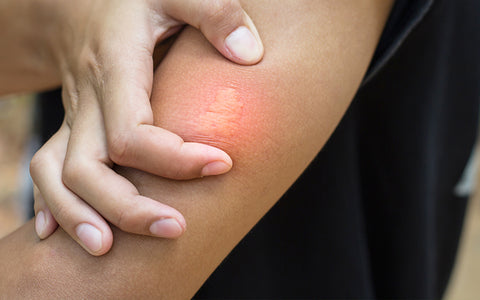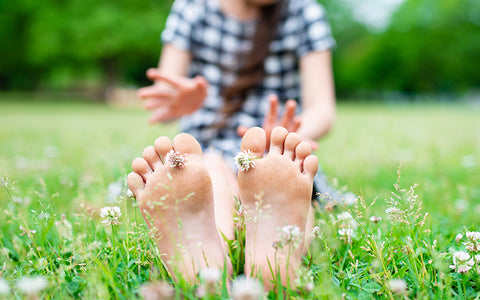What is bee allergy?
Bees are generally too busy to sting unless provoked. The people most at risk of bee stings are beekeepers and their families and neighbours. This also puts them at greater risk of bee allergy. You usually have to be stung twice for an allergy to kick in.
In this article we’ll explain bee allergies and give you practical advice on what to do if you are allergic to bee stings. Bees may be less aggressive than wasps but their venom is more likely to cause severe allergic reactions.
Bee sting allergy: the inside story
There are more than 20,000 known bee species in the world. The honeybee and bumble bee are among the stinging insects that commonly cause severe allergic reactions. But only the honeybee commonly stings in the UK.
The substances or allergens that can cause reactions to bee stings are particular proteins in the venom. Scientists have identified 12 bee venom allergens and two bumble bee venom allergens so far. If you have a bee allergy your immune system overreacts to one or more of them and makes Immunoglobulin E (IgE) antibodies to protect you. This type of allergic response usually causes symptoms like swelling, redness and pain.
Is there a bee allergy season?
Bee activity level is influenced by the seasons. They tend to fly about most in the spring and summer months. Cold weather restricts their movement and female worker bees usually cluster around the queen in the hive for the whole of winter. They’ll sting then too, if disturbed, to protect the colony.
Come spring bees start pollinating flowers once again. Spring is also swarm season for honeybees, when they reproduce. June and July are the busiest months for the colony.
|
Did you know...?
|
Mild to moderate symptoms of a bee allergy
Bee sting symptoms include pain, redness and swelling in a 10cm diameter or more around the sting site. This may last for up to a week.
Remove the stinger as soon as possible. Scrape sideways with a fingernail rather than pinching it which could push more venom under your skin. Then try some basic first aid. A cold compress or ice pack may be enough to ease pain and reduce swelling. Corticosteroid cream or calamine lotion dabbed on the sting site can be soothing too.
Ask the pharmacy for advice if your bee allergy symptoms are still uncomfortable. They may suggest an over-the-counter painkiller, corticosteroid cream or oral antihistamine. Unusually large or painful local reactions, say a swollen arm, may need medical attention and prescription antihistamines or corticosteroids.
Bee allergy: How to spot a severe allergic reaction
Anaphylaxis is a sudden and severe reaction which is potentially life-threatening. It can affect any part of the body. This might include the head (feeling faint, collapsing or losing consciousness), skin (feels clammy) or heart (fast heartbeat). It can also include your respiratory system (wheezing and trouble breathing like fast or shallow) and your brain (anxiety and confusion).
This type of anaphylactic reaction needs emergency medical care. Call an ambulance if you recognise the symptoms.
Treatment for severe bee allergy symptoms?
A serious reaction can start minutes after being stung by a bee. That’s why your GP may prescribe a device called an adrenaline auto-injector. It's for you to use in a medical emergency. Adrenaline is the main medication to counteract anaphylaxis.
A single dose may not be enough to reverse the reaction. And there may also be a second wave of symptoms a few hours later. So carry two auto-injectors with you at all times. You may need help from your family and friends. Teach them how to use one too. Carry a medical ID or wear a medical alert bracelet. This lets others know you may require prompt medical treatment after a bee sting.

Risk factors for a severe bee allergy
Some factors do seem to make severe allergic reactions to bee stings more likely:
- Being over 40 years old
- A severe reaction in the past to bee stings, yellow jackets, fire ants or wasp stings may make you more likely to have a severe reaction to a bee venom
- Allergic lower respiratory symptoms
- Mastocytosis: the body produces too many of the mast cells that are a part of your immune system
- Cardiovascular disease: a condition affecting the heart and blood vessels
Can you suddenly develop a bee allergy?
Allergic reactions usually don’t happen the first time you get a bee sting. That just sets up the possibility of bee allergy. It’s called sensitisation. Your immune system spots the venom as a threat, memorises its structure and produces specific IgE antibodies as a defence.
The next time you get a bee sting you may have an allergic reaction. The antibodies tell other cells in your body to do all they can to expel the venom. That causes your symptoms. You are now sensitized and allergic.
Diagnosing a bee allergy
Think you may have a bee allergy? Speak to your GP. They’ll ask if you have any other insect sting allergies and to describe your most severe reaction. This is to help predict the severity of future reactions.
The type of bee is important too. If it left its stinger behind in your skin, it was a honeybee. They have barbed stingers while bumblebees do not. Honeybee venom is distinctive. Other types of bee venom contain similar proteins and have a high degree of cross-reactivity. This can mean you get allergy symptoms from more than just your main trigger. Skin prick tests or allergy blood tests can help make a diagnosis.

Bee allergy: Know your frenemy
Bees are a vital part of our ecosystem The honeybee can be found everywhere from country meadows to city centres (often nesting inside wall cavities). Wild honeybees live collectively in hollow trees or other places protected from predators. Domesticated honeybees live in man-made hives. Bumble bees tend to live collectively underground in abandoned holes.
It is still possible to enjoy the outdoors in summer, even with a bee allergy. Insect repellent generally doesn’t work with stinging insects. So here are some other ways to lower the risk for yourself and others.
Practical tips for living with bee allergy
- Bees are attracted to flowers because they look bright and smell sweetly. So it’s best you avoid perfume and colourful clothing.
- Sweaty clothes and body odour can make bees angry so keep fresh in summer.
- As freeing as it may be to walk around barefoot outside, better not. Bees love lawns of nectar-rich white clover.
- Always keep picnic food covered. And be sure not to leave rubbish lying around as it can attract insects. An open fizzy drink can, empty or otherwise, is a real treat for bees.
- When bees sting they release a chemical that attracts other bees. Go indoors or into your car and keep the windows closed.
Specialist treatment for bee allergy
It may be possible to retrain your immune system so that it reacts differently. The treatment is called allergy immunotherapy and it involves regular tiny doses of your particular allergen. A full course takes three to five years and it can reduce the risk of severe insect allergy symptoms.
Specialist treatment may be right for you if you’ve already had a severe reaction. Your GP or allergist will assess and advise you.



